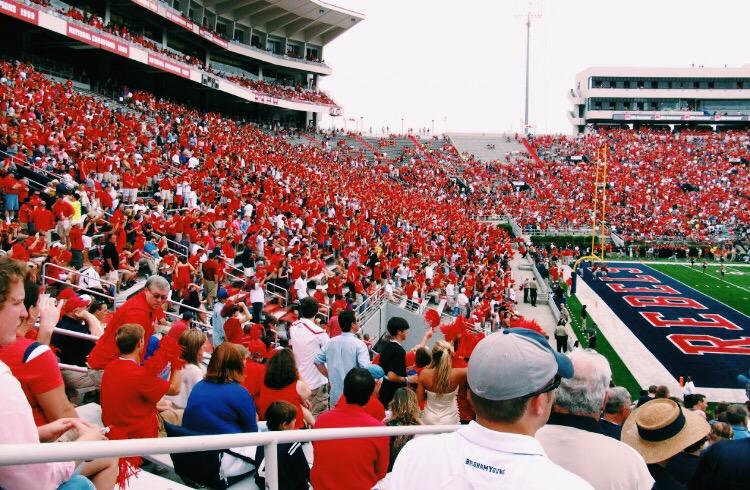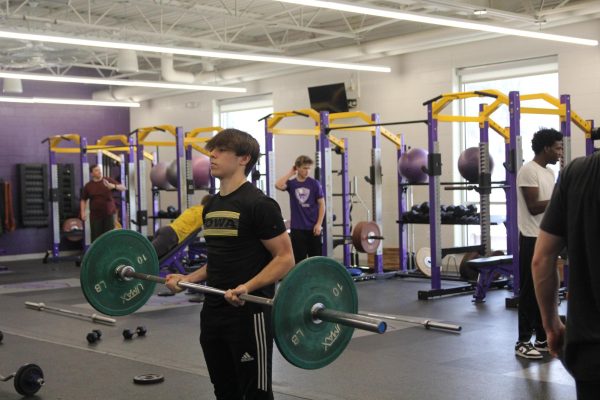Tough competition
Mizzou’s enrollment declines as students opt to attend elsewhere
The Ole Miss crowd creates a sea of red at Vaught-Hemingway Stadium as the Rebels take on the LSU Tigers , Nov. 21. An SEC school, the University of Mississppi touts top academics and athletics.
With graduation coming up in 21 days, seniors are having to make their final decision on what they will be doing after high school, including which university they will be attending.
Last year, 78 graduating seniors attended the University of Missouri Columbia. Twenty-four students attended other SEC universities. (The SEC is an American athletic conference located in the Southern part of the U.S.)
Student-athletes at EHS have shown interest in attending SEC schools.
“The SEC is big on sports which is something that I love about the universities in the conference,” Michael Maher (12) said. “You make so many memories at the football and basketball games. It’s awesome.”
Schools in the SEC have increasing enrollment numbers. Recently, the University of Mississippi reached over 23,800 students.
“We’ve always done very well with students coming out of Missouri. We expect to continue to grow at that rate,” Tom Eppes, APR, Fellow PRSA, Chief Communications Officer, University of Mississippi, said in a phone interview, conducted April 20th. “Our admissions counselors target Missouri as one of our better states for non-resident students, using direct mail, social media and personal visits. We have been very successful meeting enrollment goals with those programs.
Students attending Mizzou feel the home-field advantage.
“My whole family went to Mizzou, and my older brother goes there now,” Maher said. “It is a lot closer, and I got a lot more scholarship money from them.”
Although those Mizzou students have certain advantages. Mizzou’s enrollment numbers are going down. The Columbia Tribune reported that in 2010, out of the whole incoming freshman class, 28.2 percent were out-of-state students compared to 39.7 percent in the fall of 2015 freshmen class. Mizzou’s own site reports out-of-state freshmen at 31.3 percent for the 2015 school year.
At Mizzou a series of racial incidents took place on campus. Football players boycotted practices and went on hunger strikes. Athletes protested and boycotted games until Mr. Tim Wolfe resigned his position as president, Nov. 9. Concerned Student 1950, a group of students at Mizzou, claimed he was the blame for these racial problems.
“Mizzou’s decreasing enrollment has been because of money but specifically their minority numbers are decreasing because of racial reasons,” Mr. Jeff Buckman, career and college counselor, said. “Until they do something to their campus or have policies, it’s going to take a while for them to get their enrollment numbers back up.”
Other SEC schools are benefitting from Mizzou’s declining enrollment.
For universities around the country, a lot of out-of-state students is desirable. Out-of-state students increase geographic and ethnic diversity on campus and bring in more money.
SEC school the University of Arkansas is known for its diversity on campus. The campus was ranked the 62nd best public university in the country this past year and 129th of all universities. Enrollment figures at the university show that with 5,006 African Americans, Hispanic, Asian, Native American and Hawaiian students, the university is becoming more diverse and reflective of the state’s ethnicities.
“We are becoming more widely known and more people are hearing about us,” Ms. Susanna Yatsko, University of Arkansas admissions counselor, said in a phone interview conducted April 21. “Our rankings keep going up every year.”
Ms. Yatsko sees a direct correlation between Mizzou’s press this year and the University of Arkansas’ numbers.
“The problems at Mizzou definitely had a huge impact on our increasing enrollment,” Ms. Yatsko said. “We are getting a lot more students from Missouri because of that.”
The current racial issues at Mizzou have been brought up as an area of concern for graduating EHS seniors. Maher has seen his future dining hall in the news.
“It is starting to affect me a lot more,” Maher said. “A lot of the ‘Black Lives Matter’ happens at the dining hall I will be using, so I’m hoping it doesn’t cause any disruptions.”
Mizzou’s enrollment is decreasing.
“The most substantial influence would have been the perception in the press on what is happening here,” Mr. Patrick Elmore, University of Missouri Office of Admissions assistant director, said in a phone interview conducted April 15. “What people were seeing in St. Louis, Chicago and across the country and our primary markets in the university was probably the biggest negative.”
Mr. Buckman sees money as a real source of the decline.
Mizzou has not caught up in terms of getting the in-state students tuition. The amount they offer for the scholarships, that number has stayed the same for 10 years. They changed it a little this year and bumped it up a bit, but it’s not caught up with the price. So they are not competing anymore, Mr. Buckman said.
Mizzou runs the risk of losing its best and brightest to its SEC competition.
In the fall of 2015, preliminary enrollment figures show that the incoming freshmen class at the university had the highest A.C.T. scores in Ole Miss history, according to the University of Mississippi News.
“Ole Miss has a really good international relations program,” McKenna Gossrau (12) said. “They are a honors college, which are two things that are very important to me because I want to major in international relations.”
This bright flight extends across the SEC.
Spring of 2015, the Enrollment Profile showed that Texas A&M reached a high enrollment number of 58,577 students. However, only two percent of those numbers were out-of-state students.
Another university in the SEC that has increasing enrollment is the University of Alabama. In the fall of 2014 , Alabama topped a record of 36,000 students. Since then, Alabama’s enrollment has increased by 2.6%.
“We believe students and their parents continue choosing The University of Alabama based on the quality educational experience they receive,” Ms. Mary Spiegel, The University of Alabama Undergraduate Admissions associate provost and executive director, said in a phone interview conducted April 20.
Last spring, five graduating seniors enrolled at the University of Alabama.
“It was the visit that did it. I really love the school,” Colin Fuqua (12) said. “When I got down there everyone was so nice, and they had all the options I wanted.”
Institutions of higher education are out there actively wooing students.
“We recruit the best and brightest students from across the country. We presently have 41 regional recruiters who talk with high-school students from the recruiters’ assigned regions,” Ms. Spiegel said. “As the University has continued its growth in quality over the last decade, we’ve gradually added more recruiters to keep up with the interest.”
Mizzou recruiters are focusing on grassroots efforts, hoping that once they get potential students on campus those students will stay there.
“We just want to build on what we have. Most schools want to grow so that will be the goal,” Mr. Elmore said. “The way we are going about doing that is we have to make sure that we’re reaching out to as many people as possible and that we are starting conversations with as many people as possible and then trying to get students and their families to campus to experience and picture themselves here as a student for 4 or 5 years.”
Mr. Buckman sees that the rules of the recruitment game may need some serious tweaking if Missouri schools are going to keep Missouri students.
“Mizzou has got to find ways to fill the seats whether it’s fixing things on their end or giving out more money,” Mr. Buckman said.
Your donation will support the student journalists of Eureka High School - MO. Your contribution will allow us to purchase equipment and cover our annual website hosting costs.

This is Hannah’s third semester on the EHS hub staff. She writes her own opinions column and is a news reporter.
You can follow her on Twitter @hmellorEHS_hub....





















Ann Boennighausen • May 3, 2016 at 5:31 PM
I am afraid Mizzou has much work to do to gain the confidence of serious minded Seniors looking at schools that they want to invest 4 years at.
Ann “B”